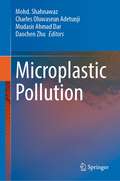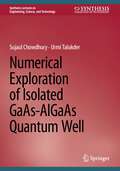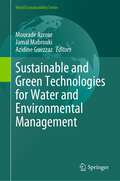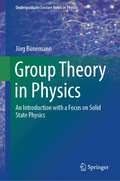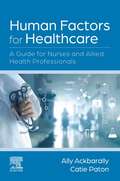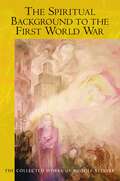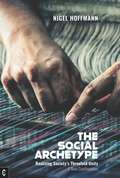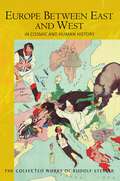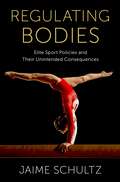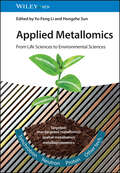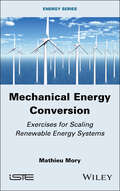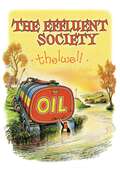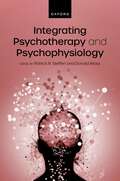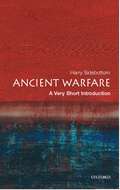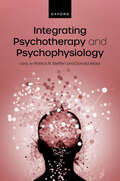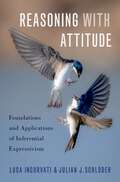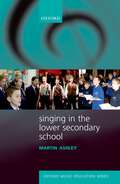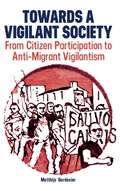- Table View
- List View
Microplastic Pollution
by Mohd. Shahnawaz Charles Oluwaseun Adetunji Mudasir Ahmad Dar Daochen ZhuThis edited volume covers cutting-edge research on different facets of microplastic pollution at the global level. The book describes different types of microplastics, their sources, transportation, extraction, identification, deleterious effects (on flora and fauna) and various mitigation measures. This book discusses recent advances in microplastic pollution and suggests future research directions to mitigate microplastic at the global level. It constitutes six important sections to report different facets of microplastic pollution. Section 1 deals with microplastic types, sources, uses and transport from land to aquatic environment; Section 2 reports detection, collections, extraction and identification of different types of microplastic from various polluting sites; Section 3 suggests cleaning drives for the removal of microplastic from the polluting sites; Section 4 highlights the impact of microplastic waste on flora and fauna in both terrestrial and aquatic environments; Section 5 enlists various microplastic degradation approaches to mitigate microplastic; and Section 6 discusses recent regulations/policies to minimize microplastic generation, followed by future research directions to mitigate microplastic pollution at global level. This book is of interest and useful to professionals working on microplastic mitigation, environment protection and waste management, NGOs and policymakers.
Numerical Exploration of Isolated GaAs-AlGaAs Quantum Well (Synthesis Lectures on Engineering, Science, and Technology)
by Sujaul Chowdhury Urmi TalukderThis book begins with the eigenvalue equation of energy and presents calculation of the energy spectrum of GaAs-AlGaAs Quantum Well using finite difference method and knowledge of potential energy profile, without using expressions for eigenfunctions, continuity of eigenfunctions, or their spatial derivatives at the two abrupt potential steps. The authors find that the results are almost the same as those obtained by solving numerically using regula falsi method, and transcendental equations that are obeyed by the energy levels, where the transcendental equations are obtained by requiring continuity of eigenfunctions and of their spatial derivatives at the two potential steps. Thus, this book confirms that it is possible to numerically calculate the energy spectrum of Quantum Well by the finite difference method when it is not correct or when it is not possible to use continuity of eigenfunctions and their spatial derivatives at the two abrupt potential steps. The authors also showthat it is possible to use the finite difference method in cases where the potential steps are non-abrupt. The book demonstrates this by calculating the energy spectrum of isolated parabolic Quantum Well of finite depth using finite difference method.
Sustainable and Green Technologies for Water and Environmental Management (World Sustainability Series)
by Mourade Azrour Jamal Mabrouki Azidine GuezzazThis book introduces a variety of the latest researches that are related to smart devices, machine learning algorithms, and the Internet of things that are applied for a sustainable environment. These recent technologies cover all fields including agriculture, transportation, smart grid, smart building, and others. In addition, IoT has provided an innovative vision that is completely alternative to the conventional methodologies: the new approach comes in the form of a single-component system that can be connected to the network and can incorporate smart policies. As a consequence, the covered subjects encompass smart system design and control, networking and machine learning, environmental monitoring and surveillance, smart meters, authentication and authorization, ensuring private data security, software solutions, and systems, among others. This book covers subjects that are related to the Internet of Things and smart used tools and methods for fighting environmental problems. Therefore, it discusses recent ideas that are not covered by other competitor books. This book is different because it can be a reference for researchers, professionals, and students in both smart thinking and environmental domains.
Digital Humanities Looking at the World: Exploring Innovative Approaches and Contributions to Society
by Sílvia Araújo Micaela Aguiar Liana ErmakovaThis edited volume explores how digital humanities can address critical societal challenges in social media, health, education, archives, heritage, and the arts. It features contributions from leading scholars and practitioners in various fields, offering a comprehensive overview of the role of digital humanities in addressing pressing social and economic issues. Designed for scholars, researchers, and practitioners in digital humanities, social sciences, arts, and cultural studies, the book highlights the potential of digital technologies to tackle today's most urgent problems, making it a valuable resource for those interested in harnessing digital innovation for societal benefit.
Group Theory in Physics: An Introduction with a Focus on Solid State Physics (Undergraduate Lecture Notes in Physics)
by Jörg BünemannThis textbook provides a didactic introduction to the topic of group theory in physics, with a special focus on solid state physics issues. The book is useful for students who encounter such problems in their first scientific work (in theory or experiment). In addition to the basic introduction to group theory and representation theory, the book deals with point groups, double point groups, and space groups, which are essential in solid state physics. As an example for systems with space group symmetry, electrons in periodic potentials are discussed. Furthermore, there are chapters on material tensors and the Wigner Eckart theorem for the evaluation of matrix elements. The latter is especially interesting for students dealing with spectroscopic problems. The content is accompanied by a series of exercises and examples. A set of solutions can be found in the appendix.
Human Factors for Healthcare E-Book: Human Factors for Healthcare E-Book
by Ally Ackbarally Catie PatonHuman factors such as fatigue and poor communication can increase the risk of safety incidents. This new book is the first to address the specific needs in this area of nurses and allied health professionals, who make up the majority of the workforce. The aim of the book is to support understanding of human factors and the role they play in quality and safety. It will help the reader identify risks, understand human error, and develop non-technical skills (social, cognitive and personal) that will support them in their practice across a range of clinical environments. With contributions by leading experts in this emerging area, many of whom remain in practice, Human Factors for Healthcare is an ideal textbook for teaching and learning in both academic and clinical settings. Covers the basic concepts right through to the most up-to-date research on human factors, including: Patient safety Human error Human factors for non-medical practitioners Human Factors in urgent, unscheduled and emergency care Non-technical skills The role of communication Teamwork Leadership Situation Awareness and Decision Making Workplace culture Stress and fatigue Resilience Reflects the requirements of the 2018 NMC Standards of Proficiency for RNs and HCPC (2023) Standards of Proficiency for AHPs. Features experts in the field from a variety of settings Embraces a broad range of speciality areas ranging from wards to A&E and ITU Contains clinical scenarios, case studies, tips and questions to help the reader reflect and engage
The Spiritual Background to the First World War
by Rudolf SteinerWith the unprecedented global conflict of the First World War as an overarching theme, Rudolf Steiner addresses timeless issues such as the search for harmony between peoples and nations, the development of the human capacity for love, the contemporary presence of Christ, and the questions of reincarnation and life after death. Speaking in the German city of Stuttgart during and after the war years, Steiner discusses the perpetual tension between East and West – particularly in relation to Europe. The war, he says, arose principally out of the Anglo-Saxon peoples' determination 'to exercise world-domination'. Knowing that Slavic culture is destined to be the precursor of the sixth cultural epoch, Western national interests resolved to make Eastern Europe – specifically Russia – 'the field for socialist experiments'. These events were aggravated by the failure of the Central European peoples in their own world-historical task, to 'rise to a broad sense of vision' as intermediaries between the two groups. Throughout, Steiner refers to the work of individual Folk Souls, but distinguishes them from the scourge of nationalism – especially when it is based on blood – whilst emphasizing the sovereignty of the individual human being. Although more than a century old, the enduring themes of these previously-untranslated lectures will resonate with many readers today. The main text is supplemented with an introduction by Simon Blaxland-de Lange, editorial notes and an index. Sixteen lectures, Stuttgart, Sept. 1914–March 1921, GA 174b
The Social Archetype: Realizing Society's Threefold Unity, A New Goetheanism
by Nigel HoffmannWe live in a time of multiple challenges to our rights and freedoms – not only in authoritarian regimes but also in liberal democracies around the globe. As the storm clouds of crisis gather, Rudolf Steiner's social vision – now a century old – offers a clear way forward. Radical in his time and still so today, Steiner's 'social threefolding' is not conceived as a logical 'system'. Rather, his picture of society as a living threefold unity, as a social 'organism', is an artistic insight that needs to be grasped imaginatively. To understand its three dimensions – the economic, the political-legal and cultural-spiritual spheres – and how they relate to each other, is to experience them inwardly. This requires a living, creative thinking that is able to enter the archetypal forces behind the concepts: a modern-day, truly Goethean approach to the social sciences. In an illuminating study, Hoffmann's dynamic presentation enables us to develop precisely such an artistic–imaginative understanding of the threefold social organism. He achieves this through clear descriptions of its principles and practical governance, whilst offering wise advice regarding the adaptation of education – at school and tertiary levels – for a threefold society.
Europe Between East and West: in Cosmic and Human History
by Rudolf SteinerIn a broad-ranging series of lectures, Rudolf Steiner shines new light on the spiritual background to the outbreak of the Great War in Europe. Spiritual entities stand behind the various peoples of the world, he says. He describes how these beings – Folk Souls – relate to the cultural diversity of Europe, America and the East, and speaks of their individual tasks and destinies in relation to the deeper causes of the catastrophic war. Central Europe has the particular mission of mediating between the Western world, the Slavic countries and by extension the East. Steiner alleges that Western secret societies consciously suppressed the spiritual life of this central cultural region through malign activities. These same brotherhoods exploited H. P. Blavatsky's occult faculties for their own ends. Given in Munich between the years 1914 and 1918 – and appearing in English for the first time – Rudolf Steiner addresses an array of topics in these lectures, including the potential elimination of the soul through specific medicines; intelligence testing as an expression of an ahrimanic trend; the stunted state of inner growth of many people after the age of 27; the effects in the spiritual world of those who die young; how war is an educator of selflessness; and the significance of Michael for the appearance of Christ in the etheric. The volume also features an introduction by Terry Boardman, editorial notes and an index. Twelve lectures, Munich, Dec. 1914–May 1918, GA 174a
Roman Architecture (Oxford History of Art)
by Janet DeLaineRoman Architecture casts new light not only on many familiar monuments of the city of Rome, but also on less well-known examples from across the Roman empire. Rome and its empire were fundamental to the development of western architecture, and its forms and motifs remain significant elements of our own built environments. Roman Architecture places the varied architecture of ancient Rome, from its humble apartment blocks to its grand public structures, within the broader context of Roman society. It takes as its starting point the writings of the Roman architect Vitruvius, as one voice in a broader contemporary debate about the nature and value of architecture. What did the Romans themselves think architecture was for? What was built, by whom and why? How was architecture represented in text and image? The interplay of type and variation that are the hallmark Roman architecture are here traced back to the human actions and choices from which they originated. Janet DeLaine explores how the desires of patrons for novelty and individuality were met by architects and builders working within the practical constraints of available materials and the moral prescriptions of religious and social norms to create new forms. Ranging from early Rome to the late empire, this volume casts new light on many familiar monuments of the city of Rome, but also on less well-known examples from across the empire. Through an examination of the key types of buildings at the heart of Roman society and their decoration, it reveals the symbolic meaning of architecture in terms of competitive power displays and commemoration, and it explores how architecture helped to define being 'Roman' at different times and in different places of the empire.
Roman Architecture (Oxford History of Art)
by Janet DeLaineRoman Architecture casts new light not only on many familiar monuments of the city of Rome, but also on less well-known examples from across the Roman empire. Rome and its empire were fundamental to the development of western architecture, and its forms and motifs remain significant elements of our own built environments. Roman Architecture places the varied architecture of ancient Rome, from its humble apartment blocks to its grand public structures, within the broader context of Roman society. It takes as its starting point the writings of the Roman architect Vitruvius, as one voice in a broader contemporary debate about the nature and value of architecture. What did the Romans themselves think architecture was for? What was built, by whom and why? How was architecture represented in text and image? The interplay of type and variation that are the hallmark Roman architecture are here traced back to the human actions and choices from which they originated. Janet DeLaine explores how the desires of patrons for novelty and individuality were met by architects and builders working within the practical constraints of available materials and the moral prescriptions of religious and social norms to create new forms. Ranging from early Rome to the late empire, this volume casts new light on many familiar monuments of the city of Rome, but also on less well-known examples from across the empire. Through an examination of the key types of buildings at the heart of Roman society and their decoration, it reveals the symbolic meaning of architecture in terms of competitive power displays and commemoration, and it explores how architecture helped to define being 'Roman' at different times and in different places of the empire.
Regulating Bodies: Elite Sport Policies and Their Unintended Consequences
by Jaime SchultzHow far are we willing to go in the name of "better sport"? Athletes have long sought to push the limits of human potential, but the advent and application of new knowledge, science, and technologies has taken elite sports into uncharted territory. It's no longer enough to break records?today's sport is about athletes surpassing their "natural" limits in the name of accomplishing the impossible. With highlights across the spectrum of professional athletics from ski jumping to horse racing, Regulating Bodies narrates the global scientization of the sports industry and the lasting influence of protective sports policies on international discourses around race, sex, identity, and impairment. While these classifications are designed to protect athletes' wellbeing in the spirit of fair play, protective policies can be shallow solutions to deeper problems?offering the appearance of care while failing to safeguard athletes from more pressing concerns. Regulating Bodies investigates the development of protective policies across topics such as gene doping and sex testing to show how current policies impede the progress of athletic development by engendering unethical and unhealthy practices at the expense of an athlete's individual rights. It offers a pathway forward beyond traditional sports categorization with alternative regulatory strategies to reflect the next generation of high-performance athletes. A scoping inquiry into the modern sports industry, Regulating Bodies asks us whether the unending quest for sporting excellence is worth the financial, social, and human toll it inevitably takes on participants at every level of elite sports.
Regulating Bodies: Elite Sport Policies and Their Unintended Consequences
by Jaime SchultzHow far are we willing to go in the name of "better sport"? Athletes have long sought to push the limits of human potential, but the advent and application of new knowledge, science, and technologies has taken elite sports into uncharted territory. It's no longer enough to break records?today's sport is about athletes surpassing their "natural" limits in the name of accomplishing the impossible. With highlights across the spectrum of professional athletics from ski jumping to horse racing, Regulating Bodies narrates the global scientization of the sports industry and the lasting influence of protective sports policies on international discourses around race, sex, identity, and impairment. While these classifications are designed to protect athletes' wellbeing in the spirit of fair play, protective policies can be shallow solutions to deeper problems?offering the appearance of care while failing to safeguard athletes from more pressing concerns. Regulating Bodies investigates the development of protective policies across topics such as gene doping and sex testing to show how current policies impede the progress of athletic development by engendering unethical and unhealthy practices at the expense of an athlete's individual rights. It offers a pathway forward beyond traditional sports categorization with alternative regulatory strategies to reflect the next generation of high-performance athletes. A scoping inquiry into the modern sports industry, Regulating Bodies asks us whether the unending quest for sporting excellence is worth the financial, social, and human toll it inevitably takes on participants at every level of elite sports.
Nuclear Physics 2: Radiochronometers and Radiopharmaceuticals
by Ibrahima SakhoNuclear Physics 2 explores the applications of various radioisotopes for dating and nuclear medicine imaging. It introduces the theoretical and experimental facts from the observation of the red shift in the spectrum of galaxies (1913), and the discovery of the cosmic microwave background (1965) that led to the validation of the Big Bang model, through which all known chemical elements are created via nucleosynthesis processes. This introduction is followed by a description of the nuclear reactions involved in primordial, stellar, and explosive. The principles of carbon-14, potassium-argon, uranium-thorium and uranium-protactinium dating, along with the principles of lead-210, caesium-137 and beryllium-7 radiochronometers applied to dating, are also described. An overview of the birth of nuclear medicine is given, from the first use of radioisotopes as tracers in plant biology in 1913, to the development of Positron Emission Tomography (PET) in 1975. The method of synthesis of radiopharmaceuticals, quality control of radiopharmaceuticals and the experimental methods of the determination of radiochemical purity are presented. The description of the principles of PET and Single-Photon Emission Tomography (SPECT), the presentation of the different radioisotopes used in TEMPS and PET, as well as the presentation of the main scintigraphies and their uses in nuclear medicine conclude the topics studied.
Applied Metallomics: From Life Sciences to Environmental Sciences
by Yu-Feng Li Hongzhe SunApplied Metallomics A groundbreaking survey of a field that unites the sciences The metallome of a cellular compartment, such as an enzyme, is the variety and arrangement of its metal ions. Metallomics is the multidisciplinary study of the metallome and its many important interactions with biological molecules and systems. It exists at the intersection of biochemistry and materials science, offering crucial insights into biological processes in which iron, for instance, plays a pivotal role. Applied Metallomics is an up-to-the-minute overview of research developments in metallomics, offering both analysis and applications in a vast array of scientific and industrial areas. Moving freely between material science, environmental science, health science, and more, it offers a comprehensive survey of this interdisciplinary research area. As the field of metallomics continues to develop and its applications expand, this book will only be a need of the hour Applied Metallomics readers will also find: Detailed treatment of nanometallomics, environmetallomics, agrometallomics, and many more Coverage of machine learning and artificial intelligence techniques with applications in metallomics An author team with vast international research experiences Applied Metallomics is ideal for researchers in many areas touched by metallomics, that include chemistry, biochemistry, biotechnology, bioinorganic chemistry, and more.
Mechanical Energy Conversion: Exercises for Scaling Renewable Energy Systems
by Mathieu MoryThis book studies the principles of mechanical energy conversion used in renewable energy sources derived from air and water: wind power, tidal power, hydroelectric power, osmotic energy, ocean thermal energy and wave energy. Mechanical Energy Conversion presents twelve application exercises and their answers. They enable the reader to first understand the physical principles of mechanical energy converters and then learn the method for sizing them. The book also reinforces the concepts of fluid mechanics and hydraulic turbo machinery, which are required to solve the exercises. This book aims to instruct readers on how to design an energy system. For each renewable energy source covered – and based on the quantity of energy or power supplied – it describes the production process, explains how it works and calculates the characteristics and dimensions of its components.
The Effluent Society
by Norman ThelwellArtist Norman Thelwell is best known for his cartoons depicting plump, petulant ponies and their young riders, but The Effluent Society shows another aspect of his work and character. Thelwell was passionate about the countryside and nature. During his life he became increasingly concerned about the impact of development, pollution and society's treatment of the environment. When The Effluent Society was first published in 1971, his concerns were way ahead of their time. Today, environmental and conservation issues are in the mainstream and have become a global priority. Although the cartoons focus on a serious topic there is no mistaking Thelwell's inimitable style. He used his talent and humour to convey a powerful message: the need to protect the environment. He also takes a wry look at modern life and so-called progress. Thelwell admitted that out of all his books, The Effluent Society was the one that gave him the greatest 'personal satisfaction' and, as such, the re-issue of this title is a fitting tribute to the artist.
Max Weber and 'The Protestant Ethic': Twin Histories
by Peter GhoshMax Weber and The Protestant Ethic: Twin Histories presents an entirely new portrait of Max Weber, one of the most prestigious social theorists in recent history, using his most famous work, The Protestant Ethic and the "Spirit" of Capitalism, as its central point of reference. It offers an intellectual biography of Weber framed along historical lines - something which has never been done before. It re-evaluates The Protestant Ethic -- a text surprisingly neglected by scholars -- supplying a missing intellectual and chronological centre to Weber's life and work. Peter Ghosh suggests that The Protestant Ethic is the link which unites the earlier (pre-1900) and later (post-1910) phases of his career. He offers a series of fresh perspectives on Weber's thought in various areas -- charisma, capitalism, law, politics, rationality, bourgeois life, and (not least) Weber's unusual religious thinking, which was 'remote from god' yet based on close dialogue with Christian theology. This approach produces a convincing view of Max Weber as a whole; while previously the sheer breadth of his intellectual interests has caused him to be read in a fragmentary way according to a series of specialized viewpoints, this volume seeks to put him back together again as a real individual.
Positive Affect Treatment for Depression and Anxiety: Workbook (Treatments That Work)
by Alicia E. Meuret Halina Dour Amanda Loerinc Guinyard Michelle G. CraskePositive Affect Treatment for Depression and Anxiety: Workbook is intended to be used by clients with clinical presentation of depression, anxiety or a loss of interest in activities. Results show that Positive Affect Treatment not only improves positive mood state but also decreases depression and anxiety. The treatment works by increasing reward sensitivity and encouraging positive emotions, rather than focusing only on reducing negative emotions. Self-assessment quizzes, homework exercises, and interactive forms allow clients to become active participants in their own treatment, whilst also monitoring progress and keeping a record of symptoms. This workbook will be an indispensable resource for individuals who wish to effectively and efficiently regain interest and enjoyment in their usual activities while improving their quality of life.
Integrating Psychotherapy and Psychophysiology: Theory, Assessment, and Practice
by Prof Patrick Steffen Prof Donald MossIn recent years there has been growing interest in exploring how psychophysiology can be used to enhance psychotherapeutic interventions, and it is becoming more common for psychotherapists to use psychophysiological approaches such as biofeedback as a part of their therapy. Integrating Psychotherapy and Psychophysiology explores how these fields can be integrated to improve therapy outcomes, and to provide a guide to professionals in the field. Structured in three parts, the first part focuses on theories underlying psychotherapy/psychophysiology integration with chapters on the neuroscience of mind, evolution and compassion, heart rate variability and mind/body integration, and affect and understanding the world. The second part focuses on assessment aspects of psychotherapy/ psychophysiology integration with chapters on the NIH Research Domain Criteria (RDoC) approach to assessment of psychopathology from a psychophysiological perspective, personality as a central factor in stress and cardiovascular reactivity and using the RDoC framework to understand and conceptualize personality. Finally, the third part focuses on approaches to integrating psychophysiology into psychotherapy, emphasizing heart rate variability biofeedback. The book will be valuable for all psychotherapists who are looking to improve their practice by integrating effective mind/body principles into their therapeutic approach.
Ancient Warfare: A Very Short Introduction (Very Short Introductions)
by Harry SidebottomGreek and Roman warfare differed from other cultures and was unlike any other forms of warfare before and after. The key difference is often held to be that the Greeks and Romans practised a 'Western Way of War', where the aim is an open, decisive battle, won by courage instilled in part by discipline. Harry Sidebottom looks at how and why this 'Western Way of War' was constructed and maintained by the Greeks and Romans, why this concept is so popular and prevalent today, and at whether or not this is an accurate interpretation. All aspects of ancient warfare are thoroughly examined - from philosophy and strategy to the technical skills needed to fight. He looks at war in the wider context - how wars could shape classical society, and how the individual's identity could be constructed by war, for example the Christian soldier fighting in God's name. He also explores the ways in which ancient society thought about conflict: Can a war be just? Why was siege warfare particularly bloody? What role did divine intervention play in the outcome of a battle? Taking fascinating examples from the Iliad, Tacitus, and the Persian Wars, Sidebottom uses arresting anecdotes and striking visual images to show that the any understanding of ancient war is an ongoing process of interpretation. ABOUT THE SERIES: The Very Short Introductions series from Oxford University Press contains hundreds of titles in almost every subject area. These pocket-sized books are the perfect way to get ahead in a new subject quickly. Our expert authors combine facts, analysis, perspective, new ideas, and enthusiasm to make interesting and challenging topics highly readable.
Integrating Psychotherapy and Psychophysiology: Theory, Assessment, and Practice
by Prof Patrick Steffen Prof Donald MossIn recent years there has been growing interest in exploring how psychophysiology can be used to enhance psychotherapeutic interventions, and it is becoming more common for psychotherapists to use psychophysiological approaches such as biofeedback as a part of their therapy. Integrating Psychotherapy and Psychophysiology explores how these fields can be integrated to improve therapy outcomes, and to provide a guide to professionals in the field. Structured in three parts, the first part focuses on theories underlying psychotherapy/psychophysiology integration with chapters on the neuroscience of mind, evolution and compassion, heart rate variability and mind/body integration, and affect and understanding the world. The second part focuses on assessment aspects of psychotherapy/ psychophysiology integration with chapters on the NIH Research Domain Criteria (RDoC) approach to assessment of psychopathology from a psychophysiological perspective, personality as a central factor in stress and cardiovascular reactivity and using the RDoC framework to understand and conceptualize personality. Finally, the third part focuses on approaches to integrating psychophysiology into psychotherapy, emphasizing heart rate variability biofeedback. The book will be valuable for all psychotherapists who are looking to improve their practice by integrating effective mind/body principles into their therapeutic approach.
Reasoning with Attitude: Foundations and Applications of Inferential Expressivism
by Luca Incurvati Julian J. Schl?derThis is an open access title available under the terms of a CC BY-NC-ND 4.0 license. It is free to read at Oxford Academic and offered as a free PDF download from OUP and selected open access locations. Certain combinations of sounds or signs on paper are meaningful. What makes it the case that, unlike most combinations of sounds or signs, they have meaning? What is this meaning that they have? And what is it to understand this meaning? This book advances new answers to these questions by developing inferential expressivism, a novel approach to the study of meaning which combines elements of the expressivist and inferentialist programs. Expressivists explain the meaning of words in terms of the attitudes that words are used to express; inferentialists explain the meaning of words in terms of the inferences that words are used to draw. Reasoning with Attitude lays out the foundations of inferential expressivism by defending the view that the meaning of an expression is to be explained in terms of the inferences we draw involving the attitudes we express. As the book shows, by joining forces, expressivism and inferentialism can meet their key challenges whilst retaining their distinctive insights and advantages. Notably, inferential expressivism solves the Frege-Geach Problem plaguing expressivism, and addresses the charge that inferentialism has limited applicability. The book demonstrates the fruitfulness of the inferential expressivist approach by applying it to several open questions in semantics from different areas of inquiry, including epistemic operators and conditionals in the philosophy of language, negation and the truth predicate in the philosophy of logic, and normative vocabulary in meta-ethics.
Singing in the Lower Secondary School (Oxford Music Education)
by Martin AshleyThis is an essential text on an important area of the music curriculum consistently judged weak or inadequate by school inspectors in Britain. It covers social, physiological, musical, and pedagogical aspects of young adolescent singing, with focus on Key Stage 3 (ages 11-14) and the progression from primary school. Grounded in extensive research and authoritatively written, it uses case studies to illustrate best practice, and introduces the principles of cambiata, a dedicated approach to the adolescent voice. Other chapters contain practical and proven advice on repertoire, technique, and the motivation of reluctant singers, boosting the confidence of teachers for whom choral work is not the main specialism.
Towards a Vigilant Society: From Citizen Participation to Anti-Migrant Vigilantism (British Academy Monographs)
by Matthijs GardenierTowards a Vigilant Society sheds light on the emergence of a new society of vigilance, in particular the actions of anti-migrant groups around Dover and Calais. Based on field research on both sides of the channel, it studies the dynamics of these groups - midway between a social movement and vigilantism - at these two key points in the international migration route between the European Union and the United Kingdom. In recent years, a series of anti-migrant groups have been mobilising on both sides of the Channel to counter migrations. Their actions range from demonstrations, to violence against migrants. And by staging their actions on social media, which is an extraordinary sounding board, these groups can build an online community and a mass audience, influencing public opinion and even the migration policies of states. This is an open access title available under the terms of a CC BY-NC-ND 4.0 International licence. It is offered as a free PDF download from OUP and selected open access locations.
